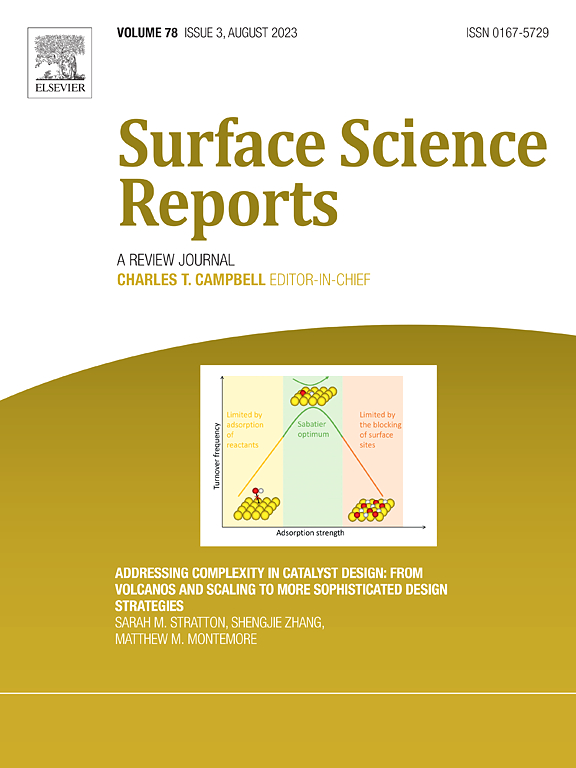二维有机拓扑绝缘体的研究进展:表面合成与表征
IF 8.7
1区 化学
Q1 CHEMISTRY, PHYSICAL
引用次数: 0
摘要
二维(2D)有机拓扑绝缘体(OTIs)由于其soc诱导的带隙和连接价带和导带的拓扑边界态而获得了越来越多的兴趣。利用基质介导的自组装的实验努力已经成功地制造了具有各种晶格对称性的二维有机框架。有机分子的巨大多样性以及有机配体与金属原子之间广泛的可能的配位相互作用引起了人们对这些框架的极大关注。然而,大规模、有序二维OTIs的实验实现仍然具有挑战性。特别是,由于费米能级附近的破坏性量子干涉,具有近平坦带的单层二维奥蒂斯的合成一直是难以捉摸的。随着合成化学和表面合成技术的进步,理论预测的二维oti的数量已逐步在实验中实现。本文综述了二维OTIs的合成和表征方面的最新进展,重点介绍了非平凡平坦带的实验鉴定。最后,我们讨论了未来的研究方向和与表征这些新型量子材料相关的挑战。本文章由计算机程序翻译,如有差异,请以英文原文为准。
Recent advances of two-dimensional organic topological insulators: surface synthesis and characterization
Two-dimensional (2D) organic topological insulators (OTIs) have garnered increasing interest due to their SOC-induced band gaps and topological boundary states that connect the valence and conduction bands. Experimental efforts utilizing substrate-mediated self-assembly have successfully fabricated 2D organic frameworks with various lattice symmetries. The vast diversity of organic molecules and the wide range of possible coordination interactions between organic ligands and metal atoms have led to significant attention toward these frameworks. However, the experimental realization of large-scale, ordered 2D OTIs remains challenging. In particular, the synthesis of monolayer 2D OTIs featuring nearly flat bands due to destructive quantum interference near the Fermi level has been elusive. With advancements in synthetic chemistry and on-surface synthesis techniques, the number of theoretically-predicted 2D OTIs has been gradually experimentally realized. This review provides a comprehensive summary of recent advances in the synthesis and characterization of 2D OTIs, with a particular focus on the experimental identification of nontrivial flat bands. Finally, we discuss future research directions and the challenges associated with characterizing these novel quantum materials.
求助全文
通过发布文献求助,成功后即可免费获取论文全文。
去求助
来源期刊

Surface Science Reports
化学-物理:凝聚态物理
CiteScore
15.90
自引率
2.00%
发文量
9
审稿时长
178 days
期刊介绍:
Surface Science Reports is a journal that specializes in invited review papers on experimental and theoretical studies in the physics, chemistry, and pioneering applications of surfaces, interfaces, and nanostructures. The topics covered in the journal aim to contribute to a better understanding of the fundamental phenomena that occur on surfaces and interfaces, as well as the application of this knowledge to the development of materials, processes, and devices. In this journal, the term "surfaces" encompasses all interfaces between solids, liquids, polymers, biomaterials, nanostructures, soft matter, gases, and vacuum. Additionally, the journal includes reviews of experimental techniques and methods used to characterize surfaces and surface processes, such as those based on the interactions of photons, electrons, and ions with surfaces.
 求助内容:
求助内容: 应助结果提醒方式:
应助结果提醒方式:


